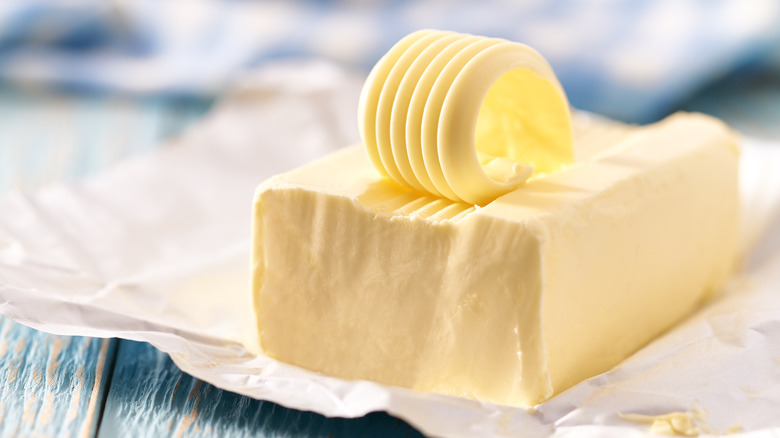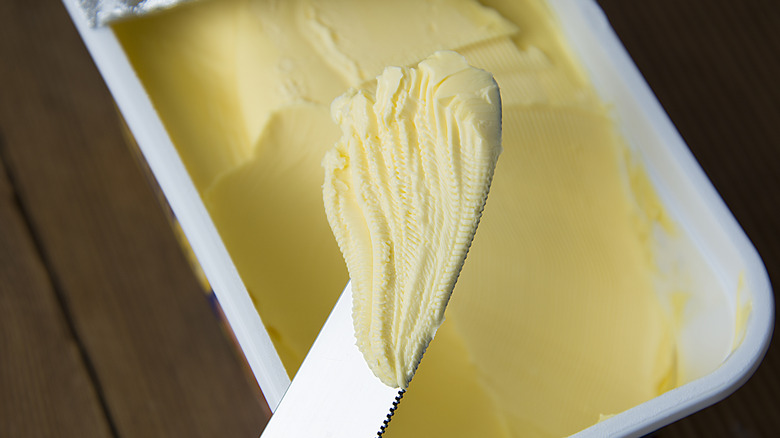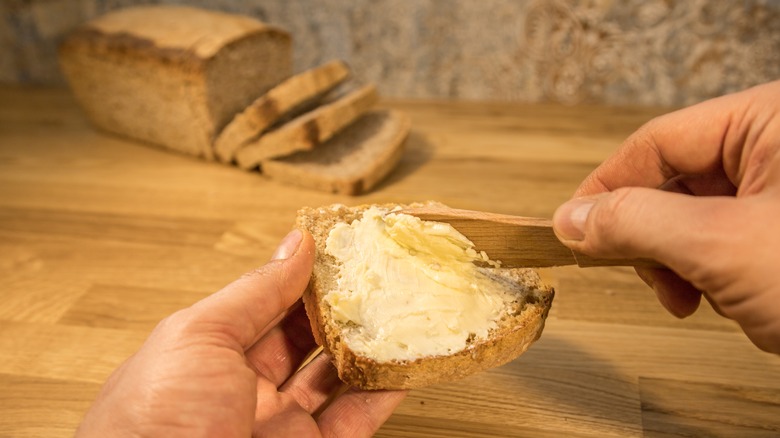The Quick Way To Make That Cold Stick Of Butter Spreadable
Even the most careful meal planner can forget certain details when it comes time to serve, especially spreadable butter. How many times have you laid out a basket of fresh bread or a platter of hot corn on the cob only to grab a hard stick of butter right out of the fridge and hope for the best? Well you don't have to settle for scraping cold chunks of butter across your next English muffin because there's a quick way to make it more spreadable. All you have to do is whip it with a little bit of water or milk with a mixer.
If you're thinking that it's easier to just buy spreadable butter in tubs at the grocery store, here's a little secret: Pretty much all spreadable butter is made by whipping water and other ingredients into butter to some degree. The nice thing about doing it yourself is that you can avoid some of the other extras that come in store-bought butters like seed oils and artificial flavorings.
Whip up a batch of butter
Creating a batch of perfectly spreadable whipped butter could not be easier to pull off. All you need is a stick of butter, a mixer, and about a tablespoon of water or milk. Let the butter come up to around room temperature so that it's not knocking around inside the bowl when you turn on the mixer, then whip the butter and water or milk together for a couple of minutes until it starts to look lighter in color and texture. That's all there is to it.
If you've already got the mixer out, however, this is also a perfect opportunity to add a few extra flavors to make your own compound butter. Try tossing in a handful of chopped herbs like thyme, tarragon, or basil. Diced garlic is also a great addition, and you can use any leftovers to make a loaf of garlic bread the next day or add a dash of everything bagel spice for a tasty morning toast spread. A pinch or teaspoon of maple syrup and brown sugar will also add some sweetness and complexity to the butter.
Storing and re-serving whipped butter
Serve your whipped butter at room temperature for optimal spreading, and if there's any leftover just cover it tightly in a container or with some plastic wrap and store it in the refrigerator like regular butter. When you're ready to serve it again, let the butter come up to room temperature on the countertop for 10 to 15 minutes and give the container a stir. If it's not warming up fast enough, you can whip it again in the mixer for about a minute, which will soften it up. Just don't try to use any heat source like the microwave or hot stove, because whipped butter has air in it so it will melt and separate very quickly.
Also, don't use heavy cream for making whipped butter. The fat in cream is what makes butter in the first place, so when it's whipped it will simply separate into butter and whey instead of making light, fluffy whipped butter. Stick to water, milk, or milk alternatives and you'll get the best results.
In addition to making spreading extra simple, the nice thing about whipped butter is that it'll stretch your butter supply by about a third. So not only will corn on the cob swabbing be a little bit easier, but your grocery bill will also thank you. Once you see how easy it is to keep whipped butter around, you'll always have a supply on hand.


